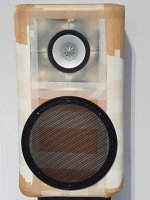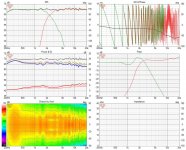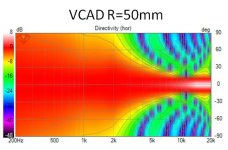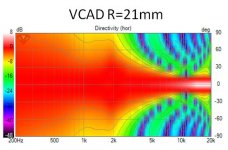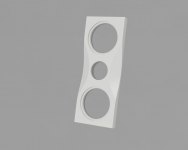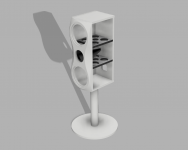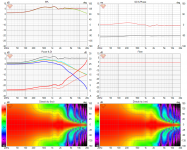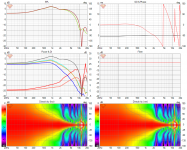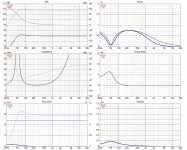Nice prints!
Here is a site of Ian's side flaps.
Curved Speaker Baffle Extensions - lostinsound.space
Here is a site of Ian's side flaps.
Curved Speaker Baffle Extensions - lostinsound.space
The one at the bottom is actually garbage because of a layer shift (it's visible at the left edge), but the others have turned out fine.
Here are some measurement results for the second waveguide design (WG2), which 220 mm by 220 mm in size. I used R=50mm as the roundover for the sides and R=21 mm for the bottom and top. The baffle dimensions are 320 mm x 570 mm.

As you can see, the tweeter response is clearly improved from WG1 and now looks fairly decent. However, there's still some irregularities in the woofer response. Most notably the narrowing at 1.6 kHz.
Next I added fiber board sidewalls and roof in order to get some idea of the response of a complete enclosure. The depth of the enclosure is around 320 mm.

With this the tweeter response is further improved. There's also some small changes in the woofer response, but nothing major. I was also running some diffraction calculations with VituixCAD on the side. Here's how it looks for the woofer depending on the edge rounding.


Clearly these don't really match with the measured woofer responses and provide no explanation for the narrowing at 1.6 kHz. However, there are some dimensions that match that frequency. The width of the waveguide is 220 mm and the distance from the center of the driver to the bottom edge of the baffle is around 450 mm. The edge roundover terminates the waveguide quite nicely to the walls and roof of the enclosure so I thought that perhaps the bottom edge could be the problem. Down there the waveguide terminates to the flat surface, which is then terminated by the edge roundover of R=21mm. On the other hand, the real enclosure would have the 10" woofer in this area. I was also planning to place a grill on top of the woofer. So there would be some diffracting/diffusing elements in between the waveguide and the bottom edge of the baffle. In order to test something towards that direction, I attached the grille to the baffle (attached photo). Here's the response with that in place.

The tweeter looks still good and there is some minor improvement in the woofer response. The narrowing is not gone though. Perhaps there's some contribution to this from both the waveguide dimensions and the baffle dimensions. Hard the say based on the data that I have at hand because neither ABEC simulations nor the diffraction calculations give much hints. Generally speaking I think a weakness of this approach is that, while it seems to work quite well for the tweeter, the woofer does not get much benefit from the waveguide but suffers from the long distance from to the baffle edge which is forced by the wave guide dimensions.
Here's a quick mock-up of the combined response.

Not amazing, but not terrible either. Looks sort of like KEF R3, but with a bit more directivity extending to lower frequencies. I suppose the biggest issues are the narrowing at 1.6 kHz and the widening between 2kHz and 5kHz.
So what's next? I don't have any clear ideas for improving this design so perhaps it's time to take a critical look on the general approach. Is this worth the effort, for example, in comparison with what Heissman has achieved using the minimal waveguide of the DXT tweeter and chamfering extending as close to it as possible (check the measurements of DXT-Mon and DXT-Wave)? A tempting alternative approach would be to go for woofer-coaxial-woofer alignment, like Zvu in their project, and CNC a chamfer which extends right to the edge of the Q100 driver in the middle. So something similar to DXT-Wave but with woofer-coax-woofer instead of WMTMW. Perhaps it would be easier to work without having to do a lot of prototyping or detailed 3D modeling of the complete speaker... Any suggestions for 8" woofers which would work well in a small sealed enclosure up to ~300Hz? 😀
Yeah I know, I was warned😀 But this is a part of my learning curve and I have enjoyed the process.
As you can see, the tweeter response is clearly improved from WG1 and now looks fairly decent. However, there's still some irregularities in the woofer response. Most notably the narrowing at 1.6 kHz.
Next I added fiber board sidewalls and roof in order to get some idea of the response of a complete enclosure. The depth of the enclosure is around 320 mm.
With this the tweeter response is further improved. There's also some small changes in the woofer response, but nothing major. I was also running some diffraction calculations with VituixCAD on the side. Here's how it looks for the woofer depending on the edge rounding.
Clearly these don't really match with the measured woofer responses and provide no explanation for the narrowing at 1.6 kHz. However, there are some dimensions that match that frequency. The width of the waveguide is 220 mm and the distance from the center of the driver to the bottom edge of the baffle is around 450 mm. The edge roundover terminates the waveguide quite nicely to the walls and roof of the enclosure so I thought that perhaps the bottom edge could be the problem. Down there the waveguide terminates to the flat surface, which is then terminated by the edge roundover of R=21mm. On the other hand, the real enclosure would have the 10" woofer in this area. I was also planning to place a grill on top of the woofer. So there would be some diffracting/diffusing elements in between the waveguide and the bottom edge of the baffle. In order to test something towards that direction, I attached the grille to the baffle (attached photo). Here's the response with that in place.
The tweeter looks still good and there is some minor improvement in the woofer response. The narrowing is not gone though. Perhaps there's some contribution to this from both the waveguide dimensions and the baffle dimensions. Hard the say based on the data that I have at hand because neither ABEC simulations nor the diffraction calculations give much hints. Generally speaking I think a weakness of this approach is that, while it seems to work quite well for the tweeter, the woofer does not get much benefit from the waveguide but suffers from the long distance from to the baffle edge which is forced by the wave guide dimensions.
Here's a quick mock-up of the combined response.
Not amazing, but not terrible either. Looks sort of like KEF R3, but with a bit more directivity extending to lower frequencies. I suppose the biggest issues are the narrowing at 1.6 kHz and the widening between 2kHz and 5kHz.
So what's next? I don't have any clear ideas for improving this design so perhaps it's time to take a critical look on the general approach. Is this worth the effort, for example, in comparison with what Heissman has achieved using the minimal waveguide of the DXT tweeter and chamfering extending as close to it as possible (check the measurements of DXT-Mon and DXT-Wave)? A tempting alternative approach would be to go for woofer-coaxial-woofer alignment, like Zvu in their project, and CNC a chamfer which extends right to the edge of the Q100 driver in the middle. So something similar to DXT-Wave but with woofer-coax-woofer instead of WMTMW. Perhaps it would be easier to work without having to do a lot of prototyping or detailed 3D modeling of the complete speaker... Any suggestions for 8" woofers which would work well in a small sealed enclosure up to ~300Hz? 😀
Yeah I know, I was warned😀 But this is a part of my learning curve and I have enjoyed the process.
Attachments
Last edited:
Forgot the mention that I tested also different roundover radii for the top edge of the baffle, but there was only barely noticeable differences.
Perhaps something like this with dual SB23MFCL45 in ~30l sealed enclosure?

Attachments
Last edited:
Add a couple of passive resistive vents for the coax and you may end up with cardioid directivity down to 350-400hz.
Hmm... That's a tempting possibility, but I don't know how well this driver would work in a leaky enclosure. Lowish sensitivity and small effective piston area. I'm also trying to limit the cone movement to keep the upper range clean. I have very limited knowledge on passive cardioids though
This is how the enclosure would look like for the woofer-coaxial-woofer approach. All drivers and the conical enclosure of the q100 driver to be mounted on the backside of the baffle, so the rear panel would be removable. The recess on the font side around the woofer opening is for a metal grill.

Here's the diffraction calculation for the mid and woofers. This is for a realistic baffle size and driver placement, but includes no edge rounding or chamfering. The actual directivity for the mid (and tweeter) is revealed by measurement once the baffle is machined. I don't think I can simulated it reliably with ABEC.
For mid

For woofers

Finally, the alignment for 2 SB23MFCL45-4 woofers in series in a 30 l sealed enclosure. The x-max is reached around 35 Hz with 220W at 109dB. Add a bit of boost with DSP for the low end and it reaches nicely to 30-35Hz which is enough for me.

What do you think? I think this could work.
Here's the diffraction calculation for the mid and woofers. This is for a realistic baffle size and driver placement, but includes no edge rounding or chamfering. The actual directivity for the mid (and tweeter) is revealed by measurement once the baffle is machined. I don't think I can simulated it reliably with ABEC.
For mid
For woofers
Finally, the alignment for 2 SB23MFCL45-4 woofers in series in a 30 l sealed enclosure. The x-max is reached around 35 Hz with 220W at 109dB. Add a bit of boost with DSP for the low end and it reaches nicely to 30-35Hz which is enough for me.
What do you think? I think this could work.
Attachments
Last edited:
Hi,
Sure it'll work. Or Seaton Sound won't have a full line around the same principle. 😉
Your sims look nice to me.
Sure it'll work. Or Seaton Sound won't have a full line around the same principle. 😉
Your sims look nice to me.
Thank you krivium. I suppose a more common choice would be to make it a tower with two woofers below the coaxial, but I like symmetry. This way I will also have a nice option to add a fourth way (a 12" or 2x10"...) if I ever move to a bigger space and need more displacement down there.
Very interesting project and not sure how I managed to miss it up to now. I have a pair of KEF R300 mid/tweeter coaxials and a bunch of SB 8" sub drivers sitting in boxes bought for a similar project which stalled when I failed to move into the house the project was bought for. Too many more pressing projects before I can get round to building anything but you've prodded me into thinking a bit more about design.
Why don't you think you could simulate reliably with ABEC given you appear to need resolution only up to about 3-5 kHz to address most of the design issues?
Why don't you think you could simulate reliably with ABEC given you appear to need resolution only up to about 3-5 kHz to address most of the design issues?
Thanks for chiming in Andy. Your planned project seems to have a lot in common with mine.
You are probably right about ABEC. It's just that my learning curve has saturated at the level where I can quite comfortably run 3D models built using Ath, but I have had neither the time nor to courage to dive deeper. Perhaps I should take another look at the ABEC instructions and fluid's project thread.
You are probably right about ABEC. It's just that my learning curve has saturated at the level where I can quite comfortably run 3D models built using Ath, but I have had neither the time nor to courage to dive deeper. Perhaps I should take another look at the ABEC instructions and fluid's project thread.
Thanks for chiming in Andy. Your planned project seems to have a lot in common with mine.
It's not planned yet! The drivers for the previous plan were only partially bought since the subs were for distributing round the room rather than for woofers which I hadn't sorted when the move changed. The current room is both less suitable for a wide beam width and for building in speakers. So the boxes are sitting there nagging at me.
You are probably right about ABEC. It's just that my learning curve has saturated at the level where I can quite comfortably run 3D models built using Ath, but I have had neither the time nor to courage to dive deeper. Perhaps I should take another look at the ABEC instructions and fluid's project thread.
Seems reasonable to me. I hadn't appreciated where you were coming from with respect to the modelling. If you are unsure about what you are doing, how long things will take, how reliable the simulations will be, etc... it may be wiser to invest the time after the first build rather than during. Even then it may not be worthwhile if you don't see enough defects/oddities in the measurements for the information in full 3D simulations to address.
By the way, if you do obtain a full set of measurements with interesting things to be seen and don't want to take the time and effort to learn about 3D simulations I might be interested in performing a set of simulations given how much may read across to my own project (if I ever get round to picking it up again!). I am unlikely to use ABEC though because it is difficult to work with and would instead first look to open source software like acousto, gmsh, salome or similar.
Last edited:
I know that feeling😀 I have managed the finish some during the lock-down, but there's still something in every room of our apartment that is nagging at me.It's not planned yet! The drivers for the previous plan were only partially bought since the subs were for distributing round the room rather than for woofers which I hadn't sorted when the move changed. The current room is both less suitable for a wide beam width and for building in speakers. So the boxes are sitting there nagging at me.
Don't worry. I started from zero with the acoustic simulations, but I have experience with other numerical work. Mainly FEM for nano/micromechanics, FDTD for subwavelength optics, and Poisson&quantum mechanics. So I sort of know how much I don't know yet, if you know what I mean. I'm also aware that ABEC is a bit difficult to work with, but Ath made the entrance easy. Now I just have some threshold to move forward with ABEC/AKABAK without the help of Ath, which would be necessary for simulating the woofer-coaxial-woofer design. Personally, I might actually find it more convenient to use Comsol for this purpose, but it would probably be less interesting for the community because ABEC/AKABAK is more accessible. But as you said, the alternative is to build and measure. Both have pros and cons. Ideally I would do both, of course. I have not decided yet and next weeks I most likely will not have much time for either.Seems reasonable to me. I hadn't appreciated where you were coming from with respect to the modelling. If you are unsure about what you are doing, how long things will take, how reliable the simulations will be, etc... it may be wiser to invest the time after the first build rather than during. Even then it may not be worthwhile if you don't see enough defects/oddities in the measurements for the information in full 3D simulations to address.
By the way, if you do obtain a full set of measurements with interesting things to be seen and don't want to take the time and effort to learn about 3D simulations I might be interested in performing a set of simulations given how much may read across to my own project (if I ever get round to picking it up again!). I am unlikely to use ABEC though because it is difficult to work with and would instead first look to open source software like acousto, gmsh, salome or similar.
Thank you for bringing up the open source alternatives by the way. I was not aware of the most of them. And yes, your help is more than welcome!
Hi MrSticha,
Nice work! I'm really interested in your project, and also in coaxial designs.
I have a question about your choice of woofers, what that bump at 800 Hz as you can see in datasheet, I think it can make some problems. What crossover frequency you will use between coax and woofers?
Sorry I seem to have forgotten to include the intended XO points in the plans. The woofer-mid XO would probably be around 200-300 Hz and mid-tweeter XO 2-2.5 kHz.
Last edited:
Thanks for answer, MrSticha,
So it's fine, crossover frequency between WOO and MID is low enough to cause a bump at 800 Hz in measurements.
In my opinion is this design great, relatively compact size* of box with stand => better to place in room. Diffraction friendly baffle with one of greatest point source coaxials. I thik this can reach almost 1st place of blind listening tests. Good idea is using of sealed box, with DSP you can "choose/try" your favourite bass response. I'm very interested in acoustical measuremnts with mounted drivers. Wish you a good luck!
* is it ~30 lt. for both of 8"?
Edit:
Sorry for my bad reading. Simulations are at 30 lt. for 2x8". With DSP correction looks good in this (small) internal volume.
So it's fine, crossover frequency between WOO and MID is low enough to cause a bump at 800 Hz in measurements.
In my opinion is this design great, relatively compact size* of box with stand => better to place in room. Diffraction friendly baffle with one of greatest point source coaxials. I thik this can reach almost 1st place of blind listening tests. Good idea is using of sealed box, with DSP you can "choose/try" your favourite bass response. I'm very interested in acoustical measuremnts with mounted drivers. Wish you a good luck!
* is it ~30 lt. for both of 8"?
Edit:
Sorry for my bad reading. Simulations are at 30 lt. for 2x8". With DSP correction looks good in this (small) internal volume.
Last edited:
I'd always go for 2xSW10.8 AC than 2xSB's - but that's just me.
Loudspeaker shop | REDCATT SW10.8 AC | DIY
Loudspeaker shop | REDCATT SW10.8 AC | DIY
If the priority is a small speaker, SB can offer almost the same as a 10 "AL bass driver. In addition, the 2x8" radiating area is larger than 1x10 ". In my opinion, a 2x8" solution is better, although I prefer aluminum drivers on bass.
- Home
- Loudspeakers
- Multi-Way
- 3-way active standmounts with coax upper end & Other UniQ adventures
